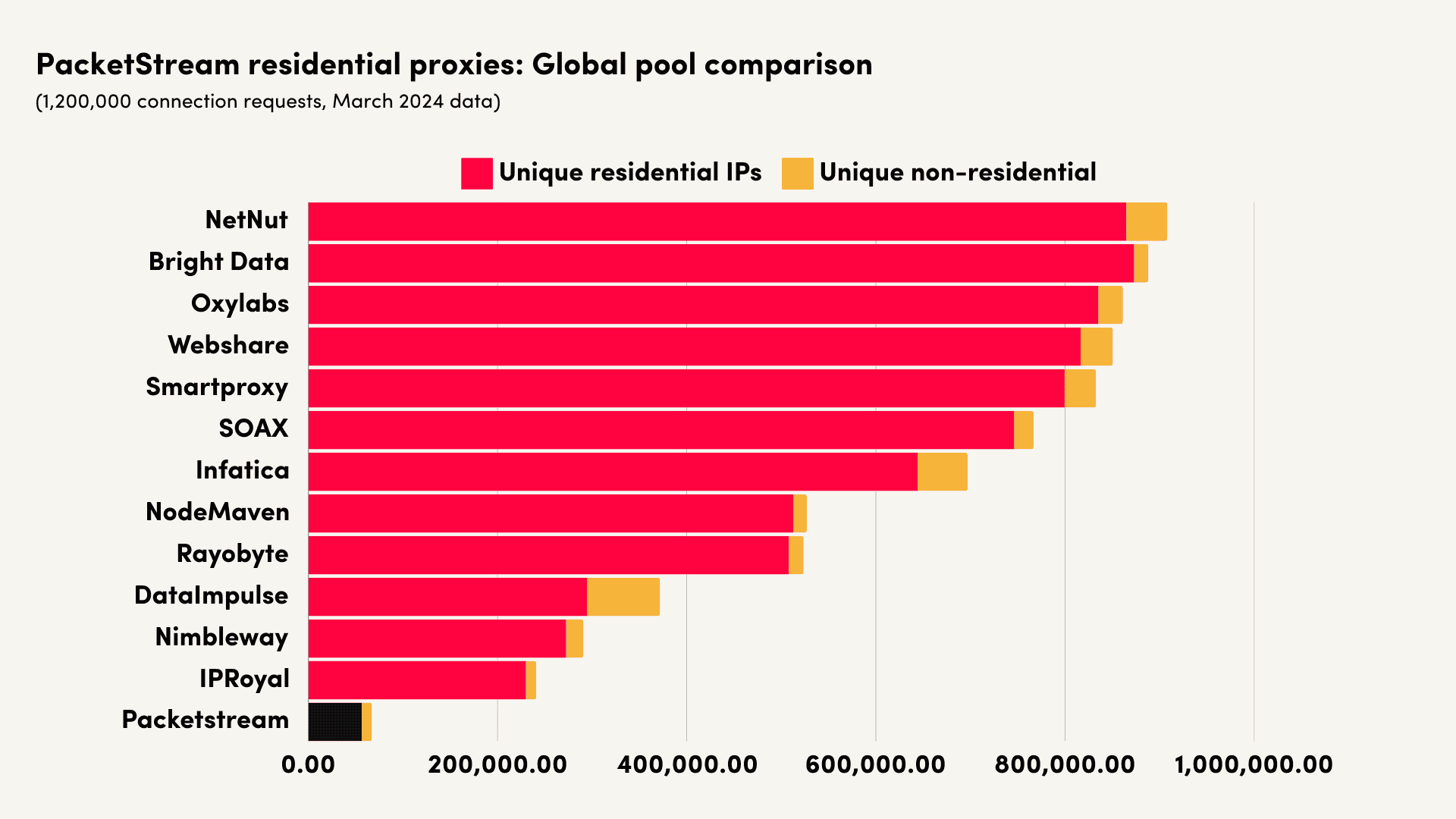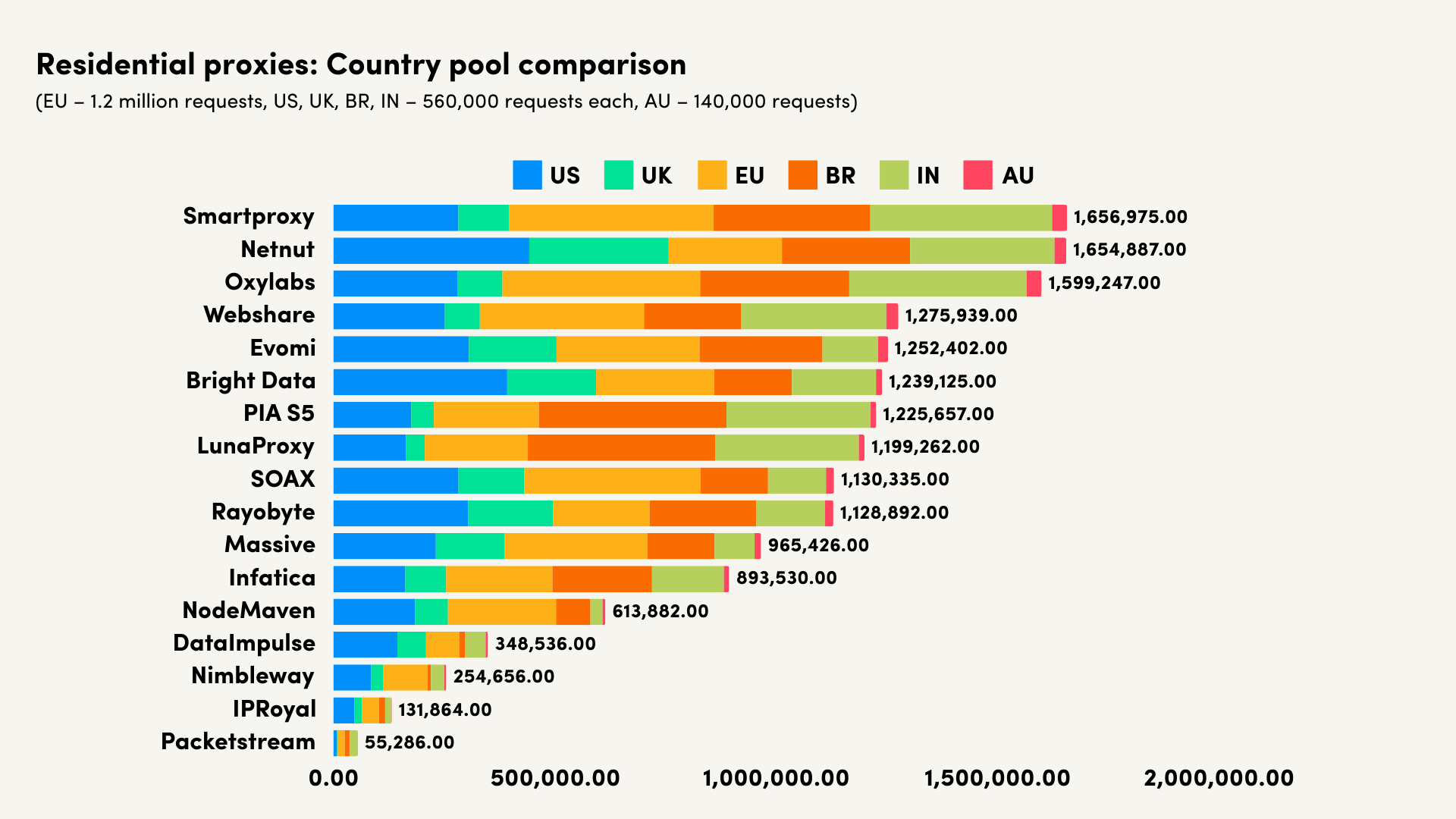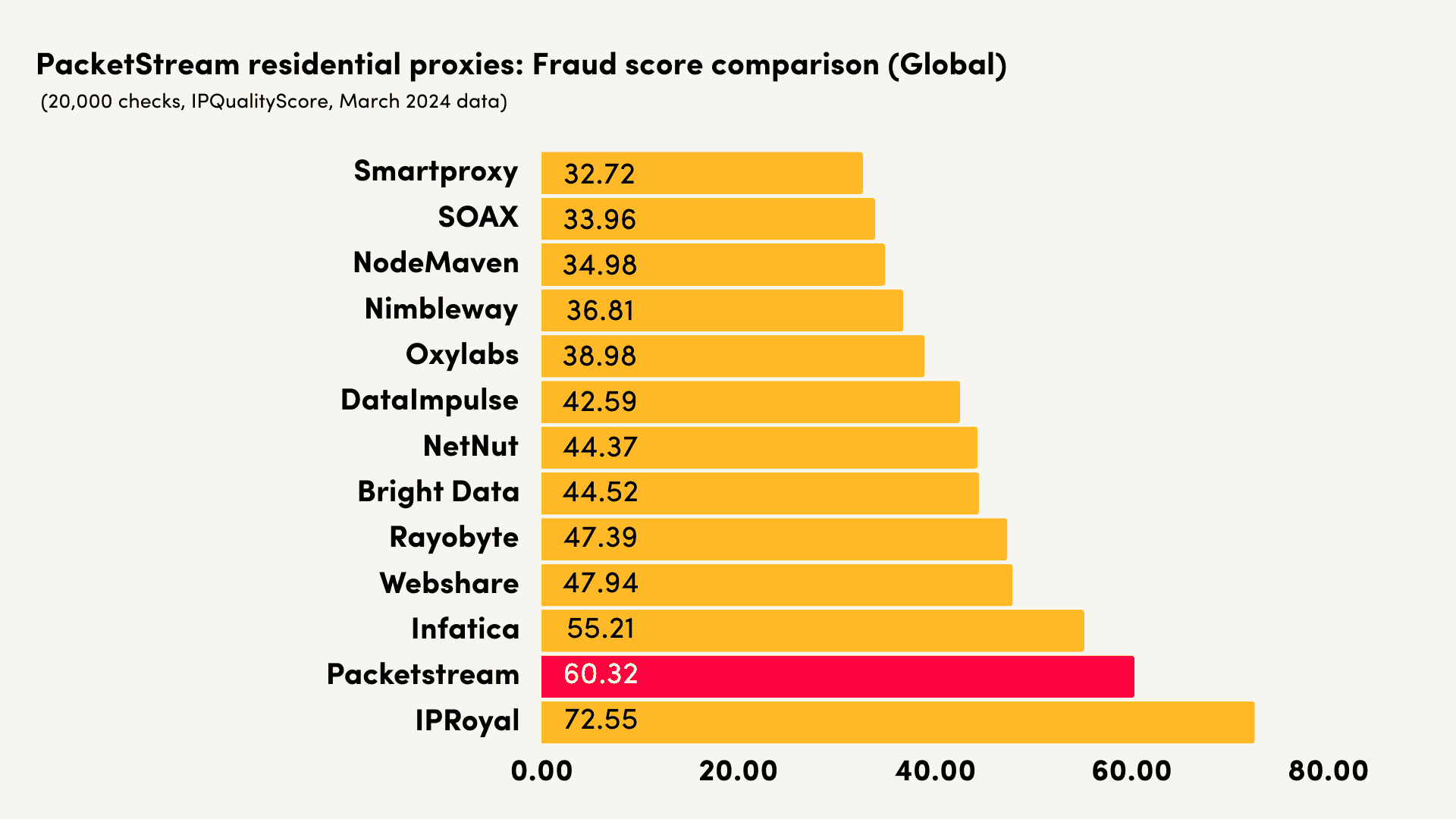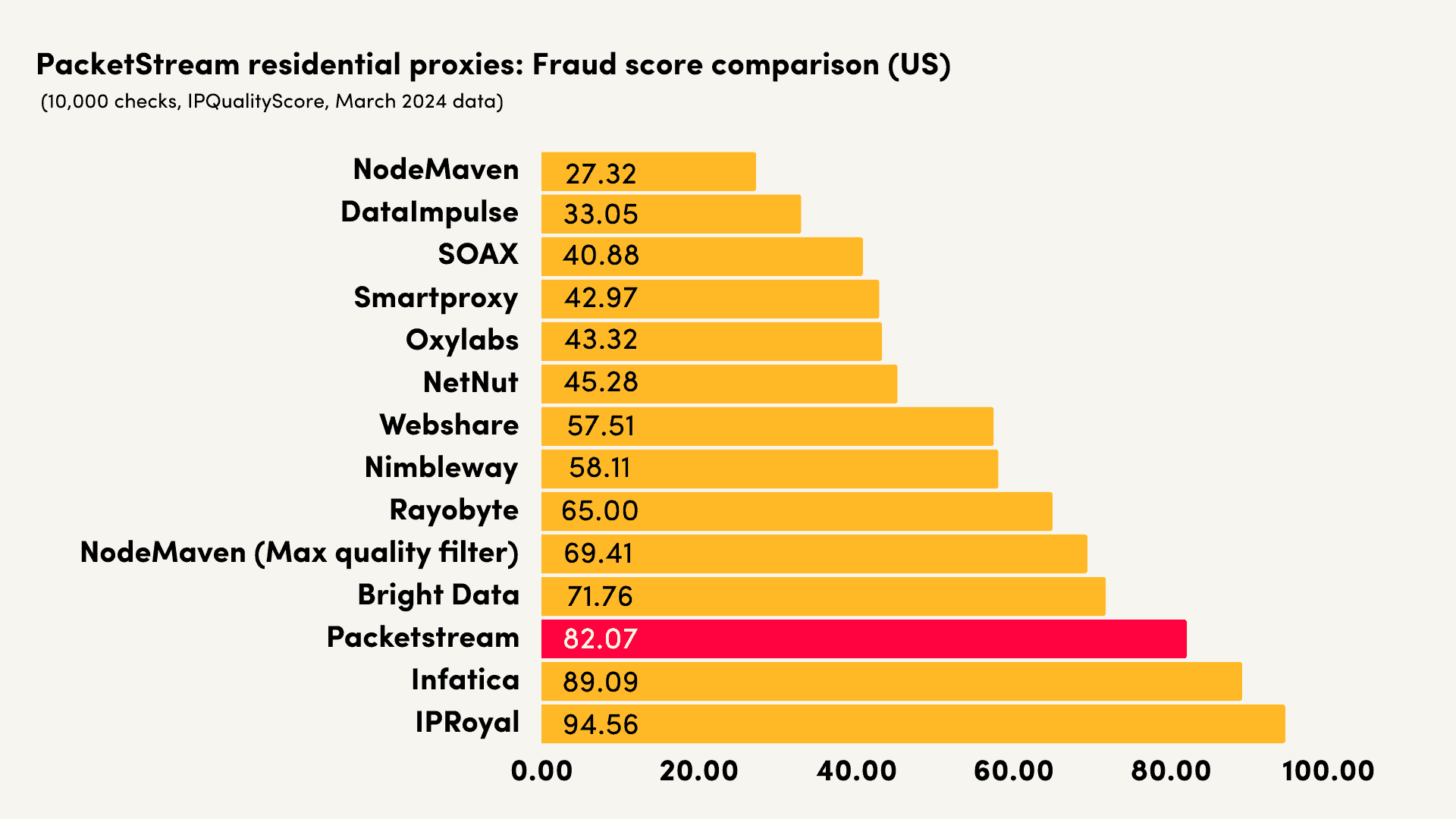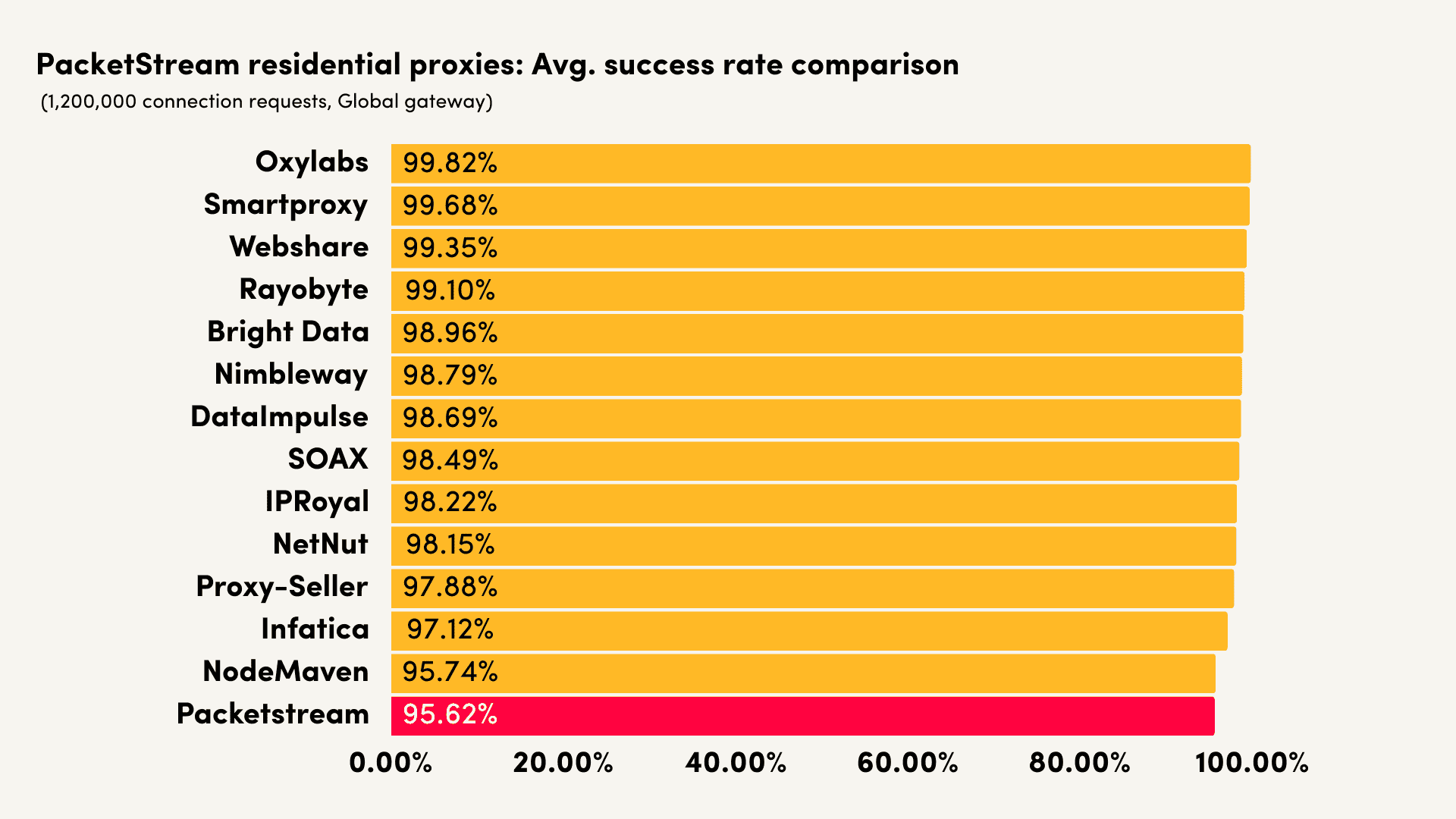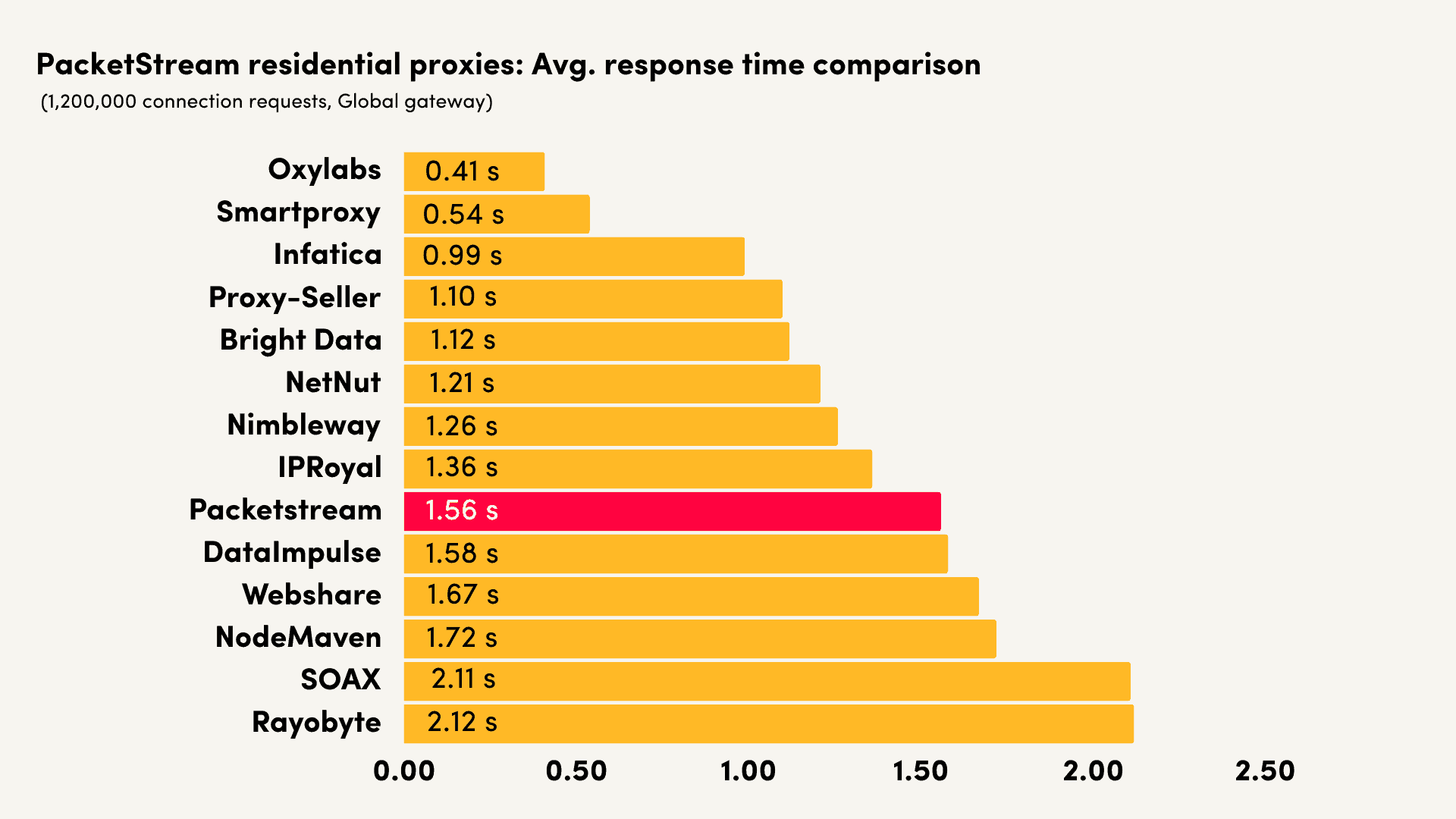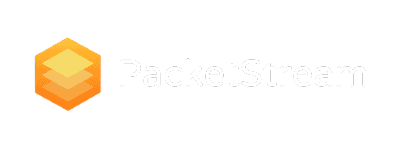
PacketStream Review
PacketStream’s proxy pool is small and plagued with technical issues that make the provider much more expensive than advertised.
$1 per gigabyte and no need to buy a subscription plan? Sounds like one heck of a deal. It sure was in 2020, when I first reviewed the provider.
Four years later, I’m no longer as optimistic. PacketStream has changed very little in a market that’s moving at a breakneck pace. I’d be hard pressed to find a difference between the provider then and now.
If it works, don’t fix it? Maybe, but the PacketStream of yore had real issues with user experience and the size of its proxy network. In this review, we’ll see where the price king stands compared to other residential proxy services, and if it’s managed to address the shortcomings.
If you’ve come from Google to read about the PacketStream bandwidth-sharing app, we compare it with similar services here.
General Information
| Country | United States |
| Founded | 2018 |
| Proxy networks | Residential |
| Other services | – |
| Supporting tools | – |
| Price range | Cheap |
| Starting price | $50 (minimum deposit) |
| Payment methods | Credit card, PayPal |
| Trial | – |
PacketStream Proxy Networks
Residential proxies are PacketStream’s only product. These IPs come from people who voluntarily share their bandwidth by installing the PacketStream app.
Pool Size & Coverage
| Advertised pool size | Locations | Targeting options |
| 7 million | 100+ countries | Global, country |
PacketStream’s advertised number of seven million IPs hasn’t changed in years. Even if we should take it at face value (when it comes to residential proxies, our advice is – don’t), it would still be among the smaller proxy networks on the market.
The proxies cover over 100 countries in the world. Their locations are listed on the dashboard; however, there’s no way to know how many IPs each has, so you’ll have to rely on the provider.
You can get IPs randomly or target particular countries. State, city, or ISP level filtering isn’t available.
Features
| Rotation | Traffic | Concurrency | Other |
| Every request, as long as available | Plan based | Unlimited threads & ports | – |
These residential proxies are peer-to-peer, so they inevitably rotate. You can choose rotation on every connection request or to keep the same IP until the source goes offline. The PacketStream app is available only for desktop OSes, so in theory the sessions should remain alive for quite a while.
The service lets you make as many parallel requests as you like, as long as there’s traffic available.
Integration & Use
| Connection method | Format | Protocols | Authentication |
| Gateway address | USERNAME:PASSWORD _country-UnitedStates_ session-SESSID @proxy.packetstream.io:31112 | HTTP HTTPS SOCKS5 | Credentials |
Like all residential proxy networks, PacketStream uses gateway servers to route your requests through end user devices. Essentially, you get one hostname (or IP address) and port to access the whole proxy network.
You can set up filters by adding parameters to the password: for example, a session ID to keep the same IP, or a country code to limit proxies to one location.
It’s possible to access the network using all three connection protocols: HTTP, HTTPS, and SOCKS5. We’re not sure whether SOCKS5 has UDP traffic available – likely not.
PacketStream lacks the option to whitelist IPs, meaning that you’ll have to make do with user:pass authentication. There are workarounds around this, but they’re less convenient than having the functionality available.
Pricing Plans
| Model | Format | Modifiers | Starting price | Trial |
| PAYG | Pay per traffic | – | $50 for 50 GB ($1/GB) | Available upon request |
Compared to some other larger providers, PacketStream sells proxies for peanuts. The pricing model is very simple: 1 GB of traffic costs $1. That’s it.
You pay for the traffic as you go, so first, you have to add some credit to your account. Then, your use of bandwidth will simply eat into this money until there’s no more left. If you want, you can hook up your credit card to auto-recharge the balance. Otherwise, top-up amounts are $50, $100, $250, $500, or $1000.
There’s one gotcha: Even though a gig costs merely $1, you have to buy at least 50 GB at a time.
During our tests, we experienced one more serious issue: PacketStream’s system overcounted traffic use by eight to ten times. Users first identified it in December 2022, and it still wasn’t fixed over a year later. Quite the opposite – the provider’s customer support repeatedly told people that everything was in order.
Performance Benchmarks
We last tested PacketStream in March 2024, for the annual Proxy Market Research.
#1: Pool size & composition
| Gateway | Parameters | Unique IPs | Residential %* |
| Global | 1.2M req, 21 days | 67,184 | 84.18% |
| US | 560k req, 14 days | 7,915 | 72.39% |
| UK | 560k req, 14 days | 2,040 | 90.10% |
| EU** | 1.2M req, 14 days | 15,471 | 94.35% |
| Brazil | 560k req, 14 days | 10,725 | 97.58% |
| India | 560k req, 14 days | 18,822 | 97.04% |
| Australia | 140k req, 7 days | 313 | 88.82% |
* IP2Location database, Usage type data point, ISP, ISP/MOB, MOB IPs.
** Combines Germany, France, Spain, Italy, the Netherlands.
As expected, PacketStream’s residential proxies had a high fraud score that was only beat by IPRoyal and in some cases Infatica. This shows a high level of abuse, or at least overuse.
#3: Infrastructure performance
This benchmark shared the same parameters as the pool test. Our scraper was located in Germany for the Global pool, and we also had scrapers in the US and Singapore for individual country pools. We targeted a global CDN – it pinged a server nearest to the proxy IP and had a response size of several kilobytes.
| Gateway | Avg. success rate | Avg. response time |
| Global | 95.62% | 1.56 s |
| US | 97.28% | 1.02 s |
| UK | 96.35% | 1.69 s |
| EU | 94.87% | 1.72 s |
| Brazil | 92.27% | 1.55 s |
| India | 92.55% | 2.40 s |
| Australia | 92.85% | 2.56 s |
#4: Performance with popular targets
We made ~2,600 connection requests to each target using US-filtered proxies. Our computer was located in the US. Note that your results may differ based on your web scraping setup.
| Website | Avg. success rate | Avg. response time |
| Amazon | 70.67% | 2.85 s |
| 11.48% | 2.27 s | |
| Social Media | 0.00% | 3.01 s |
| Total | 27.38% | 2.71 s |
How to Use PacketStream
Registration
Creating an account with PacketStream is a simple affair:
- Enter your username, email, and password
- Choose whether you want to sell traffic or buy proxies
Then, you end up in the dashboard. You don’t even need to confirm your email address.
Dashboard
Packetstream has a simple dashboard that tries to serve both sides of its business at once. One half is dedicated for traffic sellers, and the other half for proxy users. This doesn’t affect the user experience too much, as the dashboard is not yet overloaded with features.
Using it, you’ll be able to see your traffic stats, invoices, and buy bandwidth. There’s a button for contacting support as well, but it merely returns you to the FAQ page. Of course, there’s also a page for setting up proxies. Other options, such as downloading the PacketStream app or managing referrals, aren’t really relevant for proxy users.
Finally, you’ll find a form to request access to the Reseller API, if you partake in such activities. What about an API for your own proxy use? The provider says nothing about it.
All in all, the dashboard provides all that is needed to get you going. It’s light on documentation and missing quick access to customer service, but all the essentials are there.
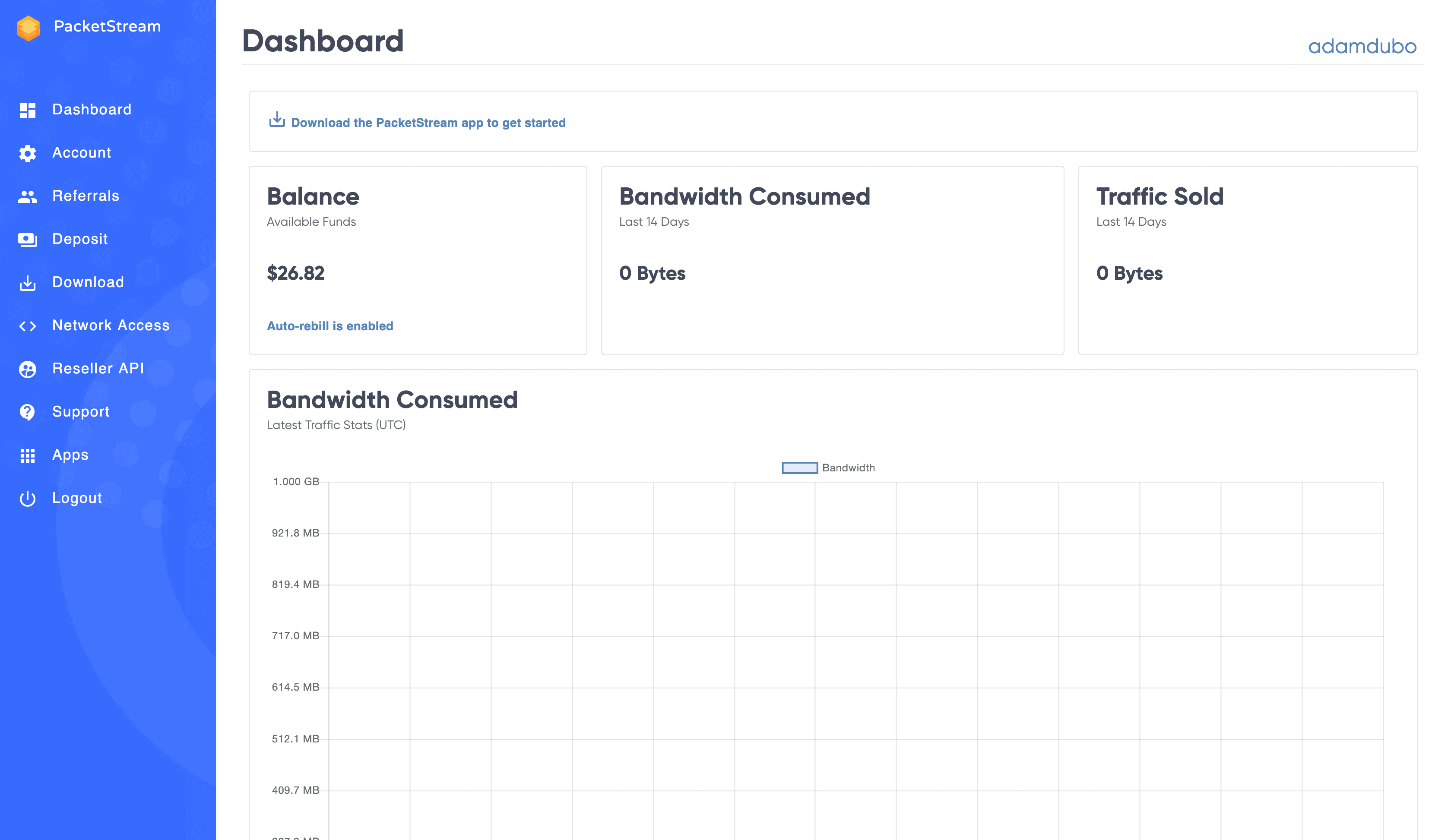
Subscription Management
PacketStream doesn’t use a subscription-based pricing model. You simply add money via a credit card or Paypal and use proxies at a rate of 1 GB for $1.
If you pay by card, PacketStream has the option to automatically recharge the balance once it falls below $1. You can choose the top-up amount. PayPal, on the other hand, supports only one-time purchases.
The dashboard generates basic invoices for your traffic purchases.
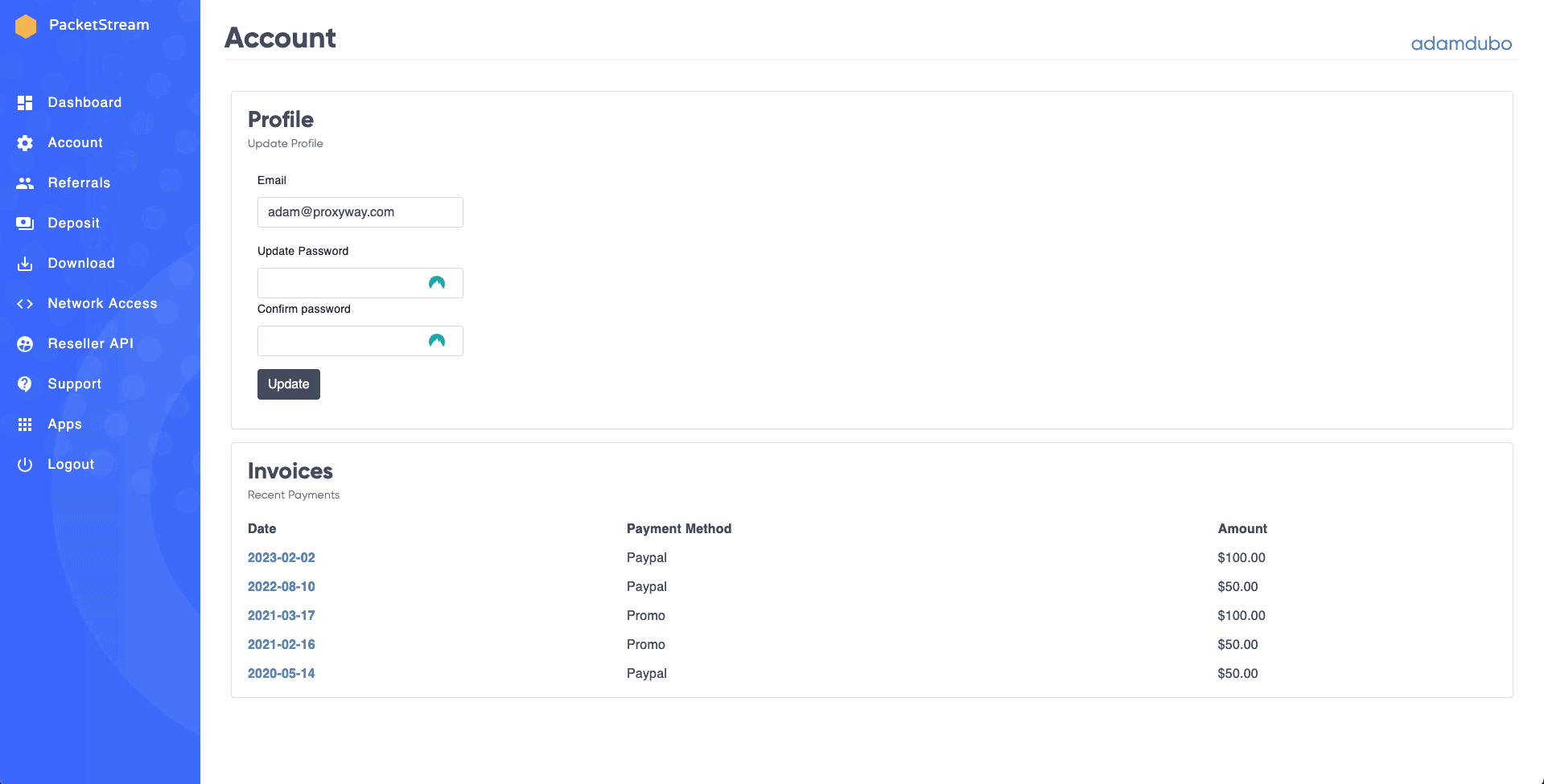
Proxy Management
To set up proxies on PacketStream, you can use the provided widget. This involves selecting items from several drop-down lists: proxy type (HTTP or SSL), whether you want the IPs to rotate, and a country. A nice touch is that you can change between DNS hostname (so, proxy.packetstream.io) and IP hostname (52.0.99.143) at will.
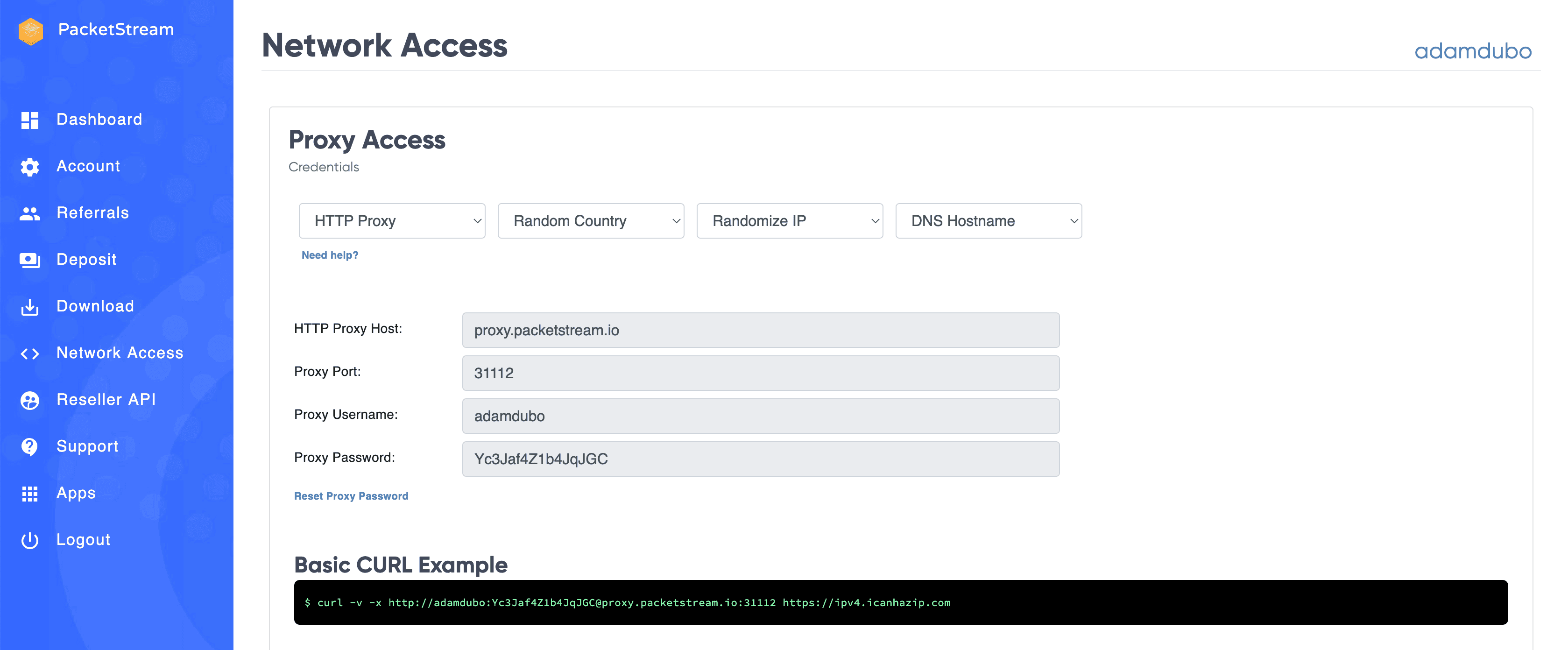
Once you’re done, PacketStream generates a proxy list with up to 10,000 IPs in several formats:

PacketStream also provides a cURL proxy string for testing the proxy server, as well as dynamic code samples for multiple programming languages: Golang, node.JS, Python, and more.

Usage Tracking
The only way regular users can track traffic expenditure is via the dashboard. On the home page, there’s a graph that shows consumed bandwidth during the last two weeks. There’s no way to change the timeframe or select custom dates.
Documentation
PacketStream’s documentation is pretty spartan. Aside from code samples, you get a basic FAQ, as well as and setup instructions with web browsers and operating systems.
There’s no start guide, configuration instructions for popular tools, or troubleshooting. Instead, PacketStream asks you to contact its customer support if you need help.
Hands-On Support
The problem is that customer support is PacketStream’s weakest point. You can reach it by email only, and help doesn’t come fast.
I contacted the provider multiple times and received a reply in 12 hours on average. However, not all customers are that lucky: I found out that in general tickets receive responses within 24 hours.
So, while PacketStream does claim to have 24/7 support, you can hardly call it so in reality. This is better than nothing, but it might not be enough for enterprise clients.
I also managed to reach the provider by Skype but was unceremoniously shooed away after being told that it’s for sales only.
Conclusion
So, that was Packetstream. What can you take away from this review?
If I had to put it in one sentence, it would sound something like this: PacketStream is lean and its pricing impressive enough to attract, but the company seems to be on life support.
If your proxy needs are simple – I’d consider PacketStream as an option. Once it manages to fix the traffic overcounting issue, the provider will once again become a strong entry option to try out residential proxies, save for perhaps Dataimpulse, Smartproxy, or IPRoyal. Just make sure you don’t need city targeting first.
If you’re an enterprise… I would hold off on PacketStream. The provider’s proxy pool is too small and its customer service too inefficient to ensure a satisfactory experience. Today, I’d go for Oxylabs or Bright Data.
PacketStream Alternatives
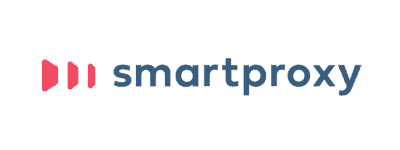
Smartproxy costs more than PacketStream. But it’s one of the strongest options among all providers, despite being priced less than premium competitors.

IPRoyal’s infrastructure performs slightly worse. In exchange, you get more IPs, better targeting options, and non-expiring plans with scalable rates.

Dataimpulse mirrors PacketStream in many ways: identical price, features, and a home-grown proxy pool. The same goes for the drawbacks, but the provider seems keen to improve.
Recommended for:
Anyone who needs cheap residential proxies without advanced features.
